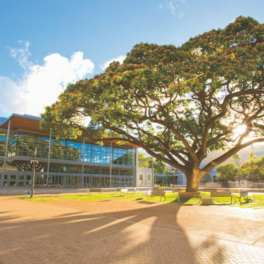Community Connections: Blake Stoner-Osborne makes deep-sea wonders visible, accessible
 Blake Stoner-Osborne (far right) offered hands-on activities, such as a lancetfish dissection, during a visit to an O'ahu high school. Credit: Sonia Rowley.
Blake Stoner-Osborne (far right) offered hands-on activities, such as a lancetfish dissection, during a visit to an O'ahu high school. Credit: Sonia Rowley. The thriving of our communities and ecosystems in Hawai‘i is intricately linked to our connection to, knowledge of, and care for the natural world. The world-class research and innovation at SOEST is intended to be informed by people and place, and accessible and beneficial to all. To honor those who reach beyond academia, we are highlighting members of SOEST who are committed to connecting and engaging with communities and students of all ages in Hawai‘i.
When Blake Stoner-Osborne was in elementary school, a classroom visit from marine biologists working at the Scripps Institution of Oceanography at the University of California San Diego (UCSD) taught him that a career focused on learning about our oceans was both possible and rewarding. Now a doctoral student in the Deep-Sea Fish Ecology Lab in the Department of Oceanography, Stoner-Osborne balances his time between connecting with students and community members and conducting research to understand how islands alter the structure and function of open ocean food webs.
“Looking back, that first classroom visit was what set me on my path to a career in marine science,” said Stoner-Osborne. “It was incredibly impactful for me to connect with those visiting scientists over shared passion for the ocean, [and for them to] share their knowledge with me and guide me towards opportunities I never knew existed. Following their suggestions, I later interned at the Birch Aquarium at UCSD which taught me that connecting with people from all walks of life about shared interests and learning from each other is such a valuable and meaningful experience.”
Now, Stoner-Osborne analyzes DNA and isotopes in specific amino acids to identify differences in the community composition of zooplankton (copepods and krill, for example) between coral reefs and open ocean habitats, and the potential these animals have for connecting the two habitats.
Outreach and communications trainee program
Recently, Stoner-Osborne was selected for the semester-long SOEST outreach and communications trainee program, through which he shared his knowledge, curiosity, and passion for deep-sea zooplankton, fishes, and general ecology with hundreds of teachers and students. He offered workshops, hands-on activities, and presentations at the Hawai‘i STEM Conference, O‘ahu high schools, and the Waikiki Aquarium’s Mauka to Makai community event.
“My experiences with outreach this semester enhanced my communication skills with a broader age range of participants,” said Stoner-Osborne. “Most of my previous outreach had been with middle and high school-aged students, but I now feel much more comfortable talking with younger age groups as well as a wide age range of adults including parents and grandparents.”
Improving access to scientific information
Stoner-Osborne continues to be motivated to connect with others and share the joy that comes from understanding the natural world. “Science is a continuously evolving field and there’s constantly more being learned about our oceans and earth systems. Facilitating connections between researchers and the general public remains one of my passions,” he said. “I think it’s massively important that everyone has access to scientific information that invites them to connect with and understand natural systems, ask new and pressing questions, and utilize information to make informed decisions.”
Funding for the SOEST Outreach and Communications Trainee program was provided by the National Science Foundation (NSF/GEO #2304691) through a Catalyst Award for Science Advancement (CASA).
Read also on UH News.




